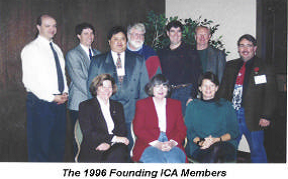A Brief History of the ICA
The international movement to reduce and prevent crime through urban design is called Crime Prevention Through Environmental Design (CPTED). The initial idea arose through the writing of journalist Jane Jacobs (1961) who wrote that we can use physical environments to reduce crime. The CPTED name itself was initially created by Professor C. Ray Jeffery (1971) and later expanded by Architect Oscar Newman in his book on Defensible Space (1972). Today CPTED is led by the International CPTED Association (ICA), a professional non-government organization dedicated to implementing CPTED around the world. The ICA's mission is: "To create safer environments and improve the quality of life through the use of CPTED principles and strategies."
Greg Saville, Barry Davidson and Paul Wong formed the International CPTED (Crime Prevention Through Environmental Design) Association in November of 1996 at our first conference in Calgary. As our name implies, we are dedicated to safe communities and improving the quality of life by implementation, promotion, and further development of CPTED strategies and design concepts. |
|
The ICA began as a venue to share ideas about CPTED and other crime prevention strategies and has grown from there. Today the ICA currently has a membership of over 200 in 33 countries! Membership includes planners, architects, developers, police, security professionals, academics, and others interested in incorporating urban safety planning and CPTED.
Since 1996, members of the ICA enhanced CPTED into a broader concept of “urban environments”, and today those concepts include preventing crime through physical/architectural environments, through neighborhood-based social environments, and, most recently, through cultural and psychological environments. These concepts are known respectively as 1st Generation and 2nd Generation CPTED. This broader version of CPTED has a significant advantage over traditional crime and justice because strategies like arrest and imprisonment do not take place until after the crime has already happened. As such, they hack at the branches of crime causation after the fact. By comparison, CPTED, aims to dig at the roots of crime by examining the places where crime happen and the opportunities and motives for crime.
Our association is unique in that it was formed initially through communication on the Internet and its primary purpose is to connect information and resources to our members through our website, newsletters, social media, various research activities, webinars, regional forums and biennial international conference. Recently we also launched the Umbrella Initiative, which provides a platform for connecting the ICA as a global organization with ICA Regions and ICA Chapters - organizations that directly apply CPTED practice on the ground.
We are the only professional organization that offers a worldwide competency based certification program for CPTED Practitioners. This program was developed over many years with consultation from around the globe. We recognized that the program would have to be competency based to allow for regional differences in application and direction. At its core our program relies on a strong understanding of the concepts of CPTED and a demonstrated ability to put those concepts into action. We currently support ICCP certified practitioners from 8 countries.
The networking and shared resources of various groups and individuals mentioned above have allowed CPTED and similar initiatives to be spread around the world and assist communities everywhere. The support of the world's top criminologists and CPTED professionals has propelled the ICA into the leading association for crime prevention professionals to belong to!
 | 1996 INAUGURAL ICA CONFERENCE BANQUET, CALGARY, CANADA FROM RIGHT TO LEFT: BARRY DAVIDSON MARY BETH RONDEAU PAT BRANTINGHAM MIKE SHEARD PAUL BRANTINGHAM (UNKNOWN) STAN CARTER SHERRY CARTER PAUL WONG GREG SAVILLE BRIAN FOOTE |
ICA Mission Statement
To create safer environments and improve the quality of life through the use of CPTED principles and strategies
